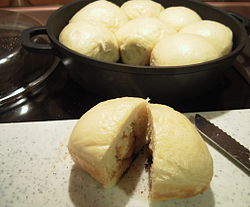Dampfnudel
 |
|
| Type | Sweet bread |
|---|---|
| Place of origin | Germany and Alsace |
| Main ingredients | Flour, water, yeast, butter or margarine; sometimes eggs or sugar |
| |
|
Dampfnudel (plural Dampfnudeln, lit. "steam-noodle"; Alsatian: Dampfnüdel) is a sort of white bread roll or sweet roll eaten as a meal or as a dessert in Germany, Austria and in France (Alsace). It is a typical dish in southern Germany.
There are Dampfnudel city gates in Freckenfeld and Kandel, two towns in the Rhineland-Palatinate, in western Germany, very near the border with French Alsace. It is reputed that, during the Thirty Years' War, Swedish troops arrived at Freckenfeld and demanded ransom. Master baker Johannes Muck, with his wife and apprentice, made 1286 Dampfnudeln to feed the soldiers, who then spared the village from further extortion and pillage. The Dampfnudeltor (Dampfnudel gate) even features on the coat of arms of the municipality of Freckenfeld.
Dampfnudeln are made from a dough composed of white flour, water, yeast, salt, butter or margarine, and sometimes also eggs and a little sugar. The dough is formed into balls about the size of an egg or a fist, left to rise and then cooked in a closed pot, preferably a high-rimmed iron pan with a lid, with milk and butter (or salt water and fat) until a golden brown crust forms at the bottom after the liquid has evaporated. The tops remain white.
...
Wikipedia
